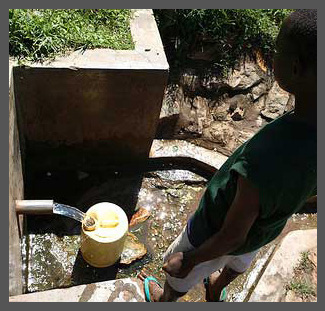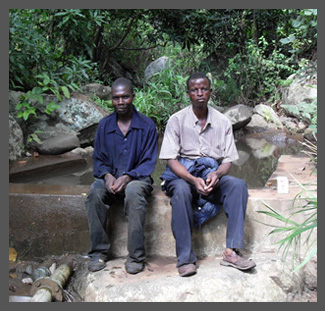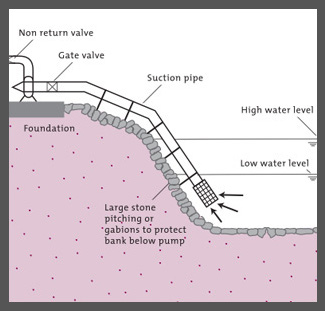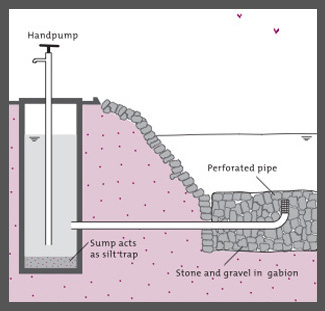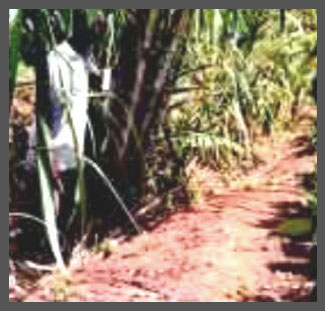Difference between revisions of "वाटर पोर्टल / वर्षाजल संचयन / सतही जल"
| (23 intermediate revisions by 2 users not shown) | |||
| Line 1: | Line 1: | ||
| − | {{Language-box|english_link=Water Portal / Rainwater Harvesting / Surface water |french_link=Eaux superficielles | spanish_link=Aguas superficiales | hindi_link=वाटर पोर्टल/ वर्षाजल संचयन/ सतही जल | malayalam_link=ഉപരിതല ജലം | korean_link=Coming soon | chinese_link=地表水(中文) | indonesian_link=Coming soon | japanese_link= 地表水 }} | + | {{Language-box|english_link=Water Portal / Rainwater Harvesting / Surface water |french_link=Eaux superficielles | spanish_link=Aguas superficiales | hindi_link=वाटर पोर्टल / वर्षाजल संचयन / सतही जल | malayalam_link=ഉപരിതല ജലം | swahili_link=coming sooon| korean_link=Coming soon | chinese_link=地表水(中文) | indonesian_link=Coming soon | japanese_link= 地表水 }} |
| − | + | वर्षा जल जो सीधे संग्रहित नहीं किया जा सकता है, कृषि में उसका इस्तेमाल किया जाता है, या जमीन में अवशोषित होकर '''सतही पानी''' बन जाता है. सतही जल संचयन में वे तमाम तंत्र शामिल हैं जिससे तूफानी बारिश या रुक-रुक कर होने वाली बरसात के बाद या धाराओं, नदियों, या झीलों के पानी का खुले तालाबों और जलाशयों में भंडारण किया जाता है. इसके जरिये सीधे घरेलू उपयोग के लिए (आम तौर पर उपचार के बाद), सिंचाई, पशुपालन, और खेती के लिए पानी उपलब्ध कर सकते हैं. भंडारण भी पानी इकट्ठा करने का लक्ष्य हो सकता है, चाहे खुले जलाशयों में हो या जमीन के नीचे जलवाही स्तर में रिसाव के माध्यम से. एक एक्वीफर में पानी का भंडारण बेहतर है, क्योंकि इसमें खुले जलाशयों जैसे वाष्पीकरण नहीं होता है. | |
<small-title /> | <small-title /> | ||
| − | ''' | + | '''जलवायु परिवर्तन विचार चिंतन'''<br> |
| − | + | पानी इकट्ठा करने वाली संरचनाओं के लिए बने सीमेंट के उपकरण, सूखे के एक समय में, कम(या प्रदूषित) पानी की वजह से खराब गुणवत्ता वाले हो सकते हैं. जलवायु परिवर्तन से अधिक गर्मी जलाशयों में वाष्पीकरण की दरों में वृद्धि करती है, या बाढ़ बुनियादी ढांचे को नुकसान पहुंचा सकती है और अपवाह की मात्रा में वृद्धि हो सकती है. इन प्रभावों को और अधिक सूचीबद्ध करते हुए जलवायु परिवर्तन की स्थिति के लिए पानी की व्यवस्था अनुकूल करने से संबंधित सुझाव दिये जा सकते हैं. | |
<div style=" background-color: #efefef; text-align: center; -moz-border-radius: 2px; -webkit-border-radius: 2px; border: 5px solid #DEDEDE; padding: 3px;" > | <div style=" background-color: #efefef; text-align: center; -moz-border-radius: 2px; -webkit-border-radius: 2px; border: 5px solid #DEDEDE; padding: 3px;" > | ||
| Line 11: | Line 11: | ||
|colspan="5" style="background-color:#efefef;"| | |colspan="5" style="background-color:#efefef;"| | ||
|- | |- | ||
| − | |style="background:#efefef;"|[[Image:SpringwaterCollecting small.jpg|center|100px|link= | + | |style="background:#efefef;"|[[Image:SpringwaterCollecting small.jpg|center|100px|link=वाटर पोर्टल/ वर्षाजल संचयन/ सतही जल/ धारे के जल का संग्रहण]] |
| − | |style="background:#efefef;"|[[Image:A river intake small.jpg|center|100px|link= | + | |style="background:#efefef;"|[[Image:A river intake small.jpg|center|100px|link=वाटर पोर्टल / वर्षाजल संचयन / सतही जल / संरक्षित तटीय जलग्रहण]] |
| − | |style="background:#efefef;"|[[Image:River-bottomIntake.JPG|center|100px|link= | + | |style="background:#efefef;"|[[Image:River-bottomIntake.JPG|center|100px|link=वाटर पोर्टल / वर्षाजल संचयन / सतही जल / नदी-तल से जल-संग्रहण]] |
| − | |style="background:#efefef;"|[[Image:Floating Intake Diagram.jpg|center|100px|link= | + | |style="background:#efefef;"|[[Image:Floating Intake Diagram.jpg|center|100px|link=वाटर पोर्टल / वर्षाजल संचयन / सतही जल / तैरता जल-संग्रहण]] |
| − | |style="background:#efefef;"|[[Image:SumpIntakeDiagram.JPG|center|100px|link= | + | |style="background:#efefef;"|[[Image:SumpIntakeDiagram.JPG|center|100px|link=वाटर पोर्टल / वर्षाजल संचयन / सतही जल / संप इनटेक]] |
|- | |- | ||
| − | |style="background:#efefef;"|<div class="center" style="width:auto; margin-left:auto; margin-right:auto;">[[ | + | |style="background:#efefef;"|<div class="center" style="width:auto; margin-left:auto; margin-right:auto;">[[वाटर पोर्टल/ वर्षाजल संचयन/ सतही जल/ धारे के जल का संग्रहण | धारे के जल का संग्रहण]]</div> |
| − | |style="background:#efefef;"|<div class="center" style="width:auto; margin-left:auto; margin-right:auto;">[[ | + | |style="background:#efefef;"|<div class="center" style="width:auto; margin-left:auto; margin-right:auto;">[[वाटर पोर्टल / वर्षाजल संचयन / सतही जल / संरक्षित तटीय जलग्रहण | संरक्षित तटीय जलग्रहण]]</div> |
| − | |style="background:#efefef;"|<div class="center" style="width:auto; margin-left:auto; margin-right:auto;">[[ | + | |style="background:#efefef;"|<div class="center" style="width:auto; margin-left:auto; margin-right:auto;">[[वाटर पोर्टल / वर्षाजल संचयन / सतही जल / नदी-तल से जल-संग्रहण | नदी-तल से जल-संग्रहण]]</div> |
| − | |style="background:#efefef;"|<div class="center" style="width:auto; margin-left:auto; margin-right:auto;">[[ | + | |style="background:#efefef;"|<div class="center" style="width:auto; margin-left:auto; margin-right:auto;">[[वाटर पोर्टल / वर्षाजल संचयन / सतही जल / तैरता जल-संग्रहण | तैरता जल-संग्रहण]]</div> |
| − | |style="background:#efefef;"|<div class="center" style="width:auto; margin-left:auto; margin-right:auto;">[[ | + | |style="background:#efefef;"|<div class="center" style="width:auto; margin-left:auto; margin-right:auto;">[[वाटर पोर्टल / वर्षाजल संचयन / सतही जल / संप इनटेक | संप इनटेक]]</div> |
|- | |- | ||
|colspan="5" style="background-color:#efefef;"| | |colspan="5" style="background-color:#efefef;"| | ||
| Line 29: | Line 29: | ||
|colspan="5" style="background-color:#efefef;"| | |colspan="5" style="background-color:#efefef;"| | ||
|- | |- | ||
| − | |style="background:#efefef;"|[[Image:Catchment dam small.jpg|center|100px|link= | + | |style="background:#efefef;"|[[Image:Catchment dam small.jpg|center|100px|link=वाटर पोर्टल / वर्षाजल संचयन / सतही जल / कैचमेंट-जलागम और भंडारण बांध]] |
| − | |style="background:#efefef;"|[[Image:Tyrolean_weir_small.JPG|center|100px|link= | + | |style="background:#efefef;"|[[Image:Tyrolean_weir_small.JPG|center|100px|link=वाटर पोर्टल / वर्षाजल संचयन / सतही जल / टाइरोलीन मेड़]] |
| − | |style="background:#efefef;"|[[Image:road runoff small.jpg|center|100px|link= | + | |style="background:#efefef;"|[[Image:road runoff small.jpg|center|100px|link=वाटर पोर्टल / वर्षाजल संचयन / सतही जल / सड़क पर बरसे जल का संचयन]] |
| − | |style="background:#efefef;"|[[Image:woman micro hydro small.jpg|center|100px|link= | + | |style="background:#efefef;"|[[Image:woman micro hydro small.jpg|center|100px|link=वाटर पोर्टल / वर्षाजल संचयन / सतही जल / लघु पनबिजली]] |
|- | |- | ||
| − | |style="background:#efefef;"|<div class="center" style="width:auto; margin-left:auto; margin-right:auto;">[[ | + | |style="background:#efefef;"|<div class="center" style="width:auto; margin-left:auto; margin-right:auto;">[[वाटर पोर्टल / वर्षाजल संचयन / सतही जल / कैचमेंट-जलागम और भंडारण बांध|कैचमेंट-जलागम <br>और भंडारण बांध]]</div> |
| − | |style="background:#efefef;"|<div class="center" style="width:auto; margin-left:auto; margin-right:auto;">[[ | + | |style="background:#efefef;"|<div class="center" style="width:auto; margin-left:auto; margin-right:auto;">[[वाटर पोर्टल / वर्षाजल संचयन / सतही जल / टाइरोलीन मेड़ | टाइरोलीन मेड़]]</div> |
| − | |style="background:#efefef;"|<div class="center" style="width:auto; margin-left:auto; margin-right:auto;">[[ | + | |style="background:#efefef;"|<div class="center" style="width:auto; margin-left:auto; margin-right:auto;">[[वाटर पोर्टल / वर्षाजल संचयन / सतही जल / सड़क पर बरसे जल का संचयन | सड़क पर बरसे<br> जल का संचयन]]</div> |
| − | |style="background:#efefef;"|<div class="center" style="width:auto; margin-left:auto; margin-right:auto;">[[ | + | |style="background:#efefef;"|<div class="center" style="width:auto; margin-left:auto; margin-right:auto;">[[वाटर पोर्टल / वर्षाजल संचयन / सतही जल / लघु पनबिजली | लघु पनबिजली]]</div> |
|- | |- | ||
|colspan="5" style="background-color:#efefef;"| | |colspan="5" style="background-color:#efefef;"| | ||
| Line 44: | Line 44: | ||
<br> | <br> | ||
| − | === | + | ===जमीनी अनुभव=== |
| − | + | इन परियोजनाओं में सतही जल संचयन तकनीक का उपयोग हो सकता है और ये [http://www.akvo.org एकेवीओ.ऑर्ग] के रियली सिंपल रिपोर्टिंग (आरएसआर) परियोजना सूची का हिस्सा हैं. | |
| − | === | + | ===सतही पानी के जानकारी से जुड़े लिंक=== |
| − | * [http://www.hpscste.gov.in/rwh/Blue_Drop_Series_02_-_Capacity_Building.pdf | + | * [http://www.hpscste.gov.in/rwh/Blue_Drop_Series_02_-_Capacity_Building.pdf वर्षा जल संचयन और उपयोगिता.] ब्लू ड्रॉप सीरीज: पुस्तक 2: बेनिफिशियरी एंड कैपिसिटी बिल्डिंग. यूएन-हैबिटाट. |
| − | * | + | * केयर नीदरलैंड, ''डेस्क स्टडी रिसिलियेंट वाश सिस्टम इन ड्राउट प्रोन एरिया''. अक्टूबर 2010. |
| − | * | + | * कृषि हेतु पानी के उपयोग पर बड़े विकि: [http://agropedia.iitk.ac.in/ एग्रोपीडिया] |
Latest revision as of 23:56, 25 February 2016
| |
|
|
|
|
|
|
|
|
वर्षा जल जो सीधे संग्रहित नहीं किया जा सकता है, कृषि में उसका इस्तेमाल किया जाता है, या जमीन में अवशोषित होकर सतही पानी बन जाता है. सतही जल संचयन में वे तमाम तंत्र शामिल हैं जिससे तूफानी बारिश या रुक-रुक कर होने वाली बरसात के बाद या धाराओं, नदियों, या झीलों के पानी का खुले तालाबों और जलाशयों में भंडारण किया जाता है. इसके जरिये सीधे घरेलू उपयोग के लिए (आम तौर पर उपचार के बाद), सिंचाई, पशुपालन, और खेती के लिए पानी उपलब्ध कर सकते हैं. भंडारण भी पानी इकट्ठा करने का लक्ष्य हो सकता है, चाहे खुले जलाशयों में हो या जमीन के नीचे जलवाही स्तर में रिसाव के माध्यम से. एक एक्वीफर में पानी का भंडारण बेहतर है, क्योंकि इसमें खुले जलाशयों जैसे वाष्पीकरण नहीं होता है.
जलवायु परिवर्तन विचार चिंतन
पानी इकट्ठा करने वाली संरचनाओं के लिए बने सीमेंट के उपकरण, सूखे के एक समय में, कम(या प्रदूषित) पानी की वजह से खराब गुणवत्ता वाले हो सकते हैं. जलवायु परिवर्तन से अधिक गर्मी जलाशयों में वाष्पीकरण की दरों में वृद्धि करती है, या बाढ़ बुनियादी ढांचे को नुकसान पहुंचा सकती है और अपवाह की मात्रा में वृद्धि हो सकती है. इन प्रभावों को और अधिक सूचीबद्ध करते हुए जलवायु परिवर्तन की स्थिति के लिए पानी की व्यवस्था अनुकूल करने से संबंधित सुझाव दिये जा सकते हैं.
जमीनी अनुभव
इन परियोजनाओं में सतही जल संचयन तकनीक का उपयोग हो सकता है और ये एकेवीओ.ऑर्ग के रियली सिंपल रिपोर्टिंग (आरएसआर) परियोजना सूची का हिस्सा हैं.
सतही पानी के जानकारी से जुड़े लिंक
- वर्षा जल संचयन और उपयोगिता. ब्लू ड्रॉप सीरीज: पुस्तक 2: बेनिफिशियरी एंड कैपिसिटी बिल्डिंग. यूएन-हैबिटाट.
- केयर नीदरलैंड, डेस्क स्टडी रिसिलियेंट वाश सिस्टम इन ड्राउट प्रोन एरिया. अक्टूबर 2010.
- कृषि हेतु पानी के उपयोग पर बड़े विकि: एग्रोपीडिया
